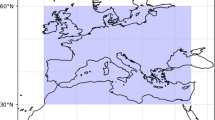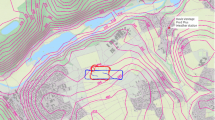Abstract
In order to study the wake vortices of landing aircraft, we carried out an experiment on the airfield of Tolmachevo Airport in 2018 using Stream Line lidar, an AMK-03 sonic anemometer, and an MTP-5 temperature profiler. The limits of applicability of the method of radial velocity in estimation of wake vortex parameters from lidar measurements were determined for different aircraft types and wind turbulence strength. The analysis of the experimental results makes it possible to identify features of the spatial dynamics and evolution of aircraft wake vortices under different states of the surface air layer. In particular, we found that the lifetime of a vortex generated behind a large MD-11F aircraft on landing can reach 4 min in the case of low average crosswind speed and moderate wind turbulence.








Similar content being viewed by others
REFERENCES
S. Kameyama, T. Ando, K. Asaka, Y. Hirano, and S. Wadaka, “Compact all-fiber pulsed coherent Doppler lidar system for wind sensing,” Appl. Opt. 46 (11), 1953–1962 (2007).
G. Pierson, F. Davies, and C. Collier, “An analysis of performance of the UFAM pulsed Doppler lidar for the observing the boundary layer,” J. Atmos. Ocean. Technol. 26 (2), 240–250 (2009).
N. Vasiljevic, G. Lea, M. Courtney, J. P. Cariou, J. Mann, and T. Mikkelsen, “Long-range wind scanner system,” Remote Sens. 8, 896 (2016).
S. Wu, B. Liu, J. Liu, X. Zhai, C. Feng, G. Wang, H. Zhang, J. Yin, X. Wang, R. Li, and D. Gallacher, “Wind turbine wake visualization and characteristics analysis by Doppler lidar,” Opt. Express 24 (10) (2016).
I. N. Smalikho and V. A. Banakh, “Estimation of aircraft wake vortex parameters from data measured with 1.5 micron coherent Doppler lidar,” Opt. Lett. 40 (14), 3408–3411 (2015).
I. N. Smalikho, V. A. Banakh, F. Holzapfel, and S. Rahm, “Method of radial velocities for the estimation of aircraft wake vortex parameters from data measured by coherent Doppler lidar,” Opt. Express 23 (19), A1194–A1207 (2015).
E. Yoshikawa and N. Matayoshi, “Aircraft wake vortex retrieval method on lidar lateral range-height indicator observation,” AIAA J. 5 (7), 2269–2278 (2017).
H. Gao, J. Li, P. W. Chan, K. K. Hon, and X. Wang, “Parameter-retrieval of dry-air wake vortices with a scanning Doppler lidar,” Opt. Express 26 (13), 16377–16392 (2018).
S. Wu, X. Zhai, and B. Liu, “Aircraft wake vortex and turbulence measurement under near-ground effect using coherent Doppler lidar,” Opt. Express 27 (2), 1142–1163 (2019).
I. N. Smalikho, V. A. Banakh, and A. V. Falits, “Measurements of aircraft wake vortex parameters by a Stream Line Doppler lidar,” Atmos. Ocean. Opt. 30 (6), 588–595 (2017).
I. N. Smalikho, “Taking into account the ground effect on aircraft wake vortices when estimating their circulation from lidar measurements,” Atmos. Ocean. Opt. 32 (6), 686–700 (2019).
V. A. Banakh and I. N. Smalikho, Coherent Doppler Wind Lidars in a Turbulent Atmosphere (Publishing House of IAO SB RAS, Tomsk, 2013) [in Russian].
T. Gerz, F. Holzapfel, and D. Darracq, “Commercial aircraft wake vortices,” Prog. Aerosp. Sci. 38, 181–208 (2002).
F. Holzapfel, “Probabilistic two-phase wake vortex decay and transport model,” J. Aircr. 40 (2), 323–331 (2003).
ACKNOWLEDGMENTS
The authors are grateful to the General Director of the Tolmachevo Airport E.Ya. Yankilevich for the opportunity to carry out the lidar measurements on the airfield.
Funding
This work was carried out within the basic research project of the Russian Academy of Sciences (no. AAAA-A17-117021310149-4). It was supported by the Russian Science Foundation (project no. 19-17-00170) as part of determining the parameters of a turbulent atmosphere.
Author information
Authors and Affiliations
Corresponding author
Ethics declarations
The authors declare that they have no conflicts of interest.
Additional information
Translated by O. Ponomareva
Rights and permissions
About this article
Cite this article
Smalikho, I.N., Banakh, V.A., Falits, A.V. et al. Experimental Study of Aircraft Wake Vortices on the Airfield of Tolmachevo Airport in 2018. Atmos Ocean Opt 33, 124–133 (2020). https://doi.org/10.1134/S1024856020020116
Received:
Revised:
Accepted:
Published:
Issue Date:
DOI: https://doi.org/10.1134/S1024856020020116




